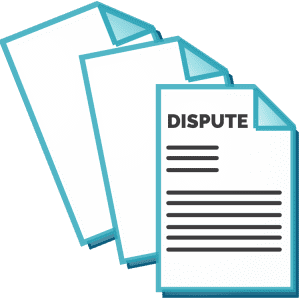
So, let’s get organized! Develop a filing system for each credit bureau. Label each one (Equifax/Experian/Transunion).
Each credit bureau folder will have a copy of your credit report inside of it as well as a copy of each dispute letter you've sent to that bureau & the certified return receipt/green card (if applicable). Each folder should have a tracking sheet stapled to it that tracks:
|
Type of Letter
|
Date Sent
|
Items Disputed
|
Response
|
Notes
|
|
EX: Verification
|
11/30/14
|
Walmart, Cap One, Midland Funding
|
Walmart – Deleted
Cap One- Verified
Midland – Updated
|
Send Method of Verification for Cap One, send Midland a Validation letter
|
If you are disputing anything directly with an original creditor or a collection agency; you can designate a separate folder for them as well.
It’s also important to KNOW YOUR RIGHTS! You are using consumer rights laws to dispute information in your credit file to ensure that every single credit trade line is 100% accurate, 100% complete, 100% verifiable, and 100% timely.
Here are the links to review the rights/laws used the most throughout the process:
Fair Credit Reporting Act (FCRA)
Fair Debt Collection Practices Act (FDCPA)
Wage Garnishment Laws by State
Before you even begin selecting a debt to dispute; know what to send to whom. We hear ‘verification letters’ and ‘validation letters’ and they often get misconstrued so let’s clear that up.
- Verification letters are sent to credit bureaus only. This is based off of the FCRA section 611 Section a(1)(A).
- Validation letters are sent to collection agencies pursuant to the FDCPA section 809.
- Investigative letters are sent to original creditors AFTER the credit bureaus have verified the debt as valid based off of Section 623(a)(8) of the FCRA. You would send a letter to the original credit asking them to conduct an investigation to ensure that the item being reported on your credit is accurate.
Now, we decide what to dispute. If the item is truly reporting inaccurately, then it’s fair game. If you’re disputing your negative info to determine if it is verifiable, please realize that not every negative item is worth going after. Check your statute of limitations for your state. This is the time frame that your state allows a creditor to sue you to enforce a debt via a judgment for wage garnishment, bank levy etc. You still owe the debt; but they are not able to enforce payment on the debt via a lawsuit. Here are statute of limitations by state:
|
State
|
Oral
|
Written
|
Promissory
|
Open-ended Accounts
|
State Statute: Open Accounts
|
|||
|
AL
|
6
|
6
|
6
|
3
|
||||
|
AR
|
5
|
5
|
5
|
3
|
||||
|
AK
|
6
|
6
|
3
|
3
|
||||
|
AZ
|
3
|
6
|
6
|
3
|
||||
|
CA
|
2
|
4
|
4
|
4
|
||||
|
CO
|
6
|
6
|
6
|
3
|
||||
|
CT
|
3
|
6
|
6
|
6
|
||||
|
DE
|
3
|
3
|
3
|
4
|
||||
|
DC
|
3
|
3
|
3
|
3
|
||||
|
FL
|
4
|
5
|
5
|
4
|
||||
|
GA
|
4
|
6
|
6
|
4**
|
||||
|
HI
|
6
|
6
|
6
|
6
|
||||
|
IA
|
5
|
10
|
5
|
5
|
||||
|
ID
|
4
|
5
|
5
|
4
|
||||
|
IL
|
5
|
10
|
10
|
5 or 10 #
|
||||
|
IN
|
6
|
10
|
10
|
6
|
||||
|
KS
|
3
|
5
|
5
|
3
|
||||
|
KY
|
5
|
15
|
15
|
5
|
||||
|
LA
|
10
|
10
|
10
|
3
|
||||
|
ME
|
6
|
6
|
6
|
6
|
||||
|
MD
|
3
|
3
|
6
|
3
|
||||
|
MA
|
6
|
6
|
6
|
6
|
||||
|
MI
|
6
|
6
|
6
|
6
|
||||
|
MN
|
6
|
6
|
6
|
6
|
||||
|
MO
|
5
|
10
|
10
|
5
|
||||
|
MS
|
3
|
3
|
3
|
3
|
§15-1-29
|
|||
|
MT
|
3
|
8
|
8
|
5
|
22-2-207
|
|||
|
NC
|
3
|
3
|
5
|
4
|
||||
|
ND
|
6
|
6
|
6
|
6
|
||||
|
NE
|
4
|
5
|
5
|
4
|
||||
|
NH
|
3
|
3
|
6
|
3
|
||||
|
NJ
|
6
|
6
|
6
|
6
|
||||
|
NM
|
4
|
6
|
6
|
4
|
||||
|
NV
|
4
|
6
|
3
|
4
|
||||
|
NY
|
6
|
6
|
6
|
6
|
||||
|
OH
|
6
|
15
|
15
|
6
|
||||
|
OK
|
3
|
5
|
5
|
3
|
||||
|
OR
|
6
|
6
|
6
|
6
|
||||
|
PA
|
4
|
6
|
4
|
6
|
||||
|
RI
|
10
|
10
|
6
|
4
|
||||
|
SC
|
3
|
3
|
3
|
3
|
||||
|
SD
|
6
|
6
|
6
|
6
|
15-2-13
|
|||
|
TN
|
6
|
4
|
6
|
6
|
||||
|
TX
|
4
|
4
|
4
|
4
|
||||
|
UT
|
4
|
6
|
6
|
4
|
||||
|
VA
|
3
|
6
|
6
|
3
|
||||
|
VT
|
6
|
6
|
5
|
4
|
||||
|
WA
|
3
|
6
|
6
|
3
|
||||
|
WI
|
6
|
6
|
10
|
6
|
||||
|
WV
|
5
|
15
|
6
|
4
|
||||
|
WY
|
8
|
10
|
10
|
8
|
||||
**In GA credit cards have a 6yrs SOL #In IL, 5yrs if Oral; 10yrs if Written
(For more info visit: http://protectingconsumerrights.com/debt-collection-problems/statute-of-limitations-by-state/)
So, now that you have your rights; let’s get to analyzing those reports. I have another post on how to obtain and read your credit report here.
Step 1: Opt out of prescreened offers; no sense in giving access to your report without your permission. Go to www.optoutprescreen.com
Step 2: Review all of your personal information to ensure it’s all reporting accurately. Your name addresses, etc. Although this has no impact on your score; all of this info was reported by the creditor when they supplied your information to the bureaus. If you see anything wrong; have it updated. NOTE: If my clients have moved often, I always have them remove older addresses for purposes of identity theft, so I often suggest this as the first letter that goes out to the bureaus; asking for older addresses to be removed.
Step 3: Make a list of the items reporting negatively on your credit. Organize them by type:
Credit Inquiries, Late Payments, Past Due Payments, Collections, Court Judgments, Loan default, Repossession, Foreclosure, Bankruptcy, etc
Make sure to notate the date of last activity, recording date, closed date, and date of last payment.
Date of last activity is the last activity on the account; in some bureau reports it’s the date of last payment; in others it’s truly the last date any activity was reported. The reporting date lets you know the last time the creditor supplied or reported information about that line item to the bureaus. Closed date is when the account was closed, and date of last payment is self-explanatory. This lets you know what date to start counting from to be removed from both your credit report and when your state’s statute of limitations begin.
Now let’s go over the easier items to remove: Outdated accounts; Late payments on closed accounts 3+ years old; Paid accounts that used to be late; Settled charged-off accounts; Authorized user accounts; Accounts that don’t belong to you; Verifiable inaccuracies.
Harder to remove accounts: Public Records, Unpaid Judgments, Unpaid Tax Liens, Child Support, New negative item: New Foreclosures, New Repossessions, New Late Payments, New Bankruptcies.
I will state that focusing on older items has a higher chance of getting removed; but it will not significantly boost your score because… well its old! Negative debts fall under your Payment History, which is 35% of your score.
If we were to break down how the age of the debt factors into that 35% it would be:
Debts that are 0-12mths old affect 40% of that 35% Payment History
Debts that are 12-24mths old affect 30% of that 35% Payment History
Debts that are 24-36mths old affect 20% of that 35% Payment History
Debts that are 36-48mths old affect 10% of that 35% Payment History
Debts older than 4yrs have very little to no effect on your Payment History.
This is why a lot of financial experts state that negotiating payment for deletion is key for newer debts. It works 40-60% of the time and it does give your score a nice little boost and works primarily for collections. For original creditors your negotiations would be based on getting the credit trade line updated to ‘Paid As Agreed’ or ‘Paid In Full’ taking off the charge offs and/or late payment statuses, which will give your score a boost. If that fails; and you want to pay them just to get them out your hair; pay them; take the hit to your credit (paid charge offs and paid collections look better than unpaid to lenders) and then dispute with the credit bureaus for a deletion. If the account is a current creditor but with late payments on it you can rely on your prior positive payment history with them; your current relationship with them, or inform them of what you were going through to cause the last payments and how you have rectified the situation; asking them to delete the late payments as a courtesy – this is called a Goodwill Letter.
What are some common reasons you can use to dispute:
Not mine
I have no record of being late on x/xx/xx date
Wrong Amount (balance, high limit, credit limit, charge off amount, or any other figure)
Wrong Date (Activity, Open, Payment, Filing date (public records))
Account number is wrong
Status is incorrect (not in charge off, not in collections, etc)
Original Creditor is wrong
The charge-off amount is wrong.
Account is outdated
Past Statute of limitation for reporting
Never contracted with the company (another way of saying not mine)
Inaccurate/Incorrect
Most start out with ‘Not Mine’ and if it comes back as verified they start to attack the other items within the credit trade line. I'm not a big fan of disputing anything as not yours when it can easily be proven that it is. It's a complete waste of time. Focus on factual errors, true inaccuracies and you'll increase your chances of improving your credit scores in a much faster time frame.
Key points:
· Letters to credit bureaus you can send regular mail, I recommend Certified Mail or First Priority Mail; no return receipt necessary.
o Attach a copy of your ID/ Utility Company with current address; SSN Card for Identity Purposes,
· Letters sent to Collection Agencies/3rd Party Debt Collectors should ALWAYS be sent Certified or First Priority Mail Return Receipt, do not sign the letter; do not sign the letter; do not sign the letter!
· Letters sent to Original Creditors (Investigative Letters, Goodwill Letters) should be sent Certified Mail Return Receipt.
· It can take several rounds of disputes to get an item removed from your credit report; so don't get discouraged if an account comes back as ‘verified'. Simply re-dispute. Keep track of the reason you used for each dispute in the notes section of your tracking form along with a copy of the dispute letter.
· The best disputes are ones that follow the 1-2 PUNCH approach. Namely you dispute with both the original creditor/collection agencies AND the bureaus.
· Use your Consumer Rights Laws to your advantage!
· BE PERSISTENT!
Tools/Resources to help you along the way:
Credit on FIre Academy ~ My Members Club, where I personally teach consumers, just like you, how to Repair, Restore & Rebuild their Credit Scores!
DIY Credit Repair Kit ~ Get my Master Credit Repair Guide, over 100 Dispute Letter Templates & More!
My Signature Credit Repair Services! ~ My team and I LOVE helping people Soar their Credit Scores, if you're looking to hire a firm to improve your credit for you, look no further! We create a customized plan of action for each client to secure RESULTS!
Good luck! And of course, if you need direction, have a question feel free to ask inside my free online community 🙂
~ Netiva








